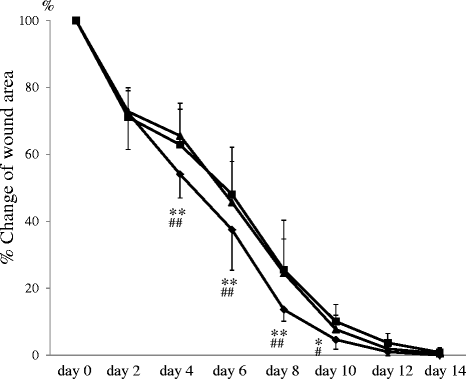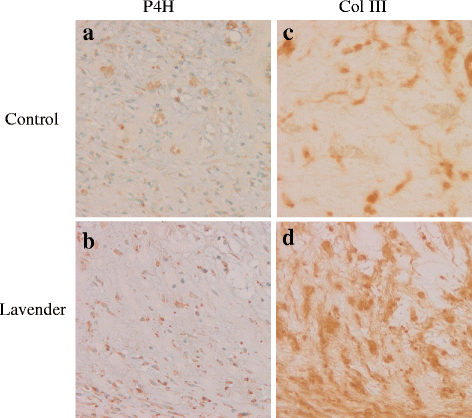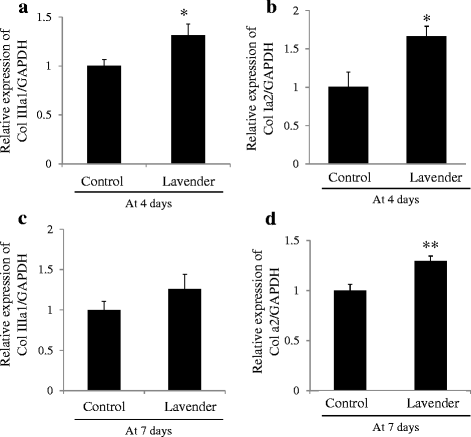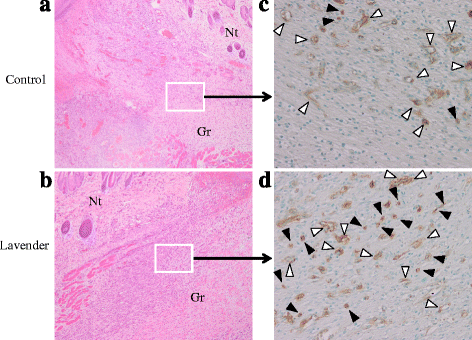Wound healing potential of lavender oil by acceleration of granulation and wound contraction through induction of TGF-β in a rat model
- PMID: 27229681
- PMCID: PMC4880962
- DOI: 10.1186/s12906-016-1128-7
Wound healing potential of lavender oil by acceleration of granulation and wound contraction through induction of TGF-β in a rat model
Abstract
Background: Although previous studies have suggested that lavender oil promote wound healing, no study has examined the molecular mechanisms of its effect. In this study, we investigated the effect of lavender oil on various steps of wound healing and its molecular mechanism, focusing on transforming growth factor-β (TGF-β).
Methods: Circular full-thickness skin wounds were produced on rats. Control solution or lavender oil was topically applied to the wounds on alternating days for 14 days.
Results: The area of wounds topically treated with lavender oil was significantly decreased as compared to that of wounds of control rats at 4, 6, 8, and 10 days after wounding. Topical application of lavender oil induced expression of type I and III collagen at 4 days after wounding, accompanied by an increased number of fibroblasts, which synthesize collagen. Induced expression of type III collagen by topical application of lavender oil was reduced to control level at 7 days after wounding although increased expression of type I collagen still continued even at 7 days, suggesting rapid collagen replacement from type III to type I in wounds treated with lavender oil. Importantly, expression of TGF-β in wounds treated with lavender oil was significantly increased as compared to control. Moreover, an increased number of myofibroblasts was observed in wounds treated with lavender oil at 4 days after wounding, suggesting promotion of differentiation of fibroblasts through induction of TGF-β, which is needed for wound contraction.
Conclusion: This study demonstrated that topical application of lavender oil promoted collagen synthesis and differentiation of fibroblasts, accompanied by up-regulation of TGF-β. These data suggest that lavender oil has the potential to promote wound healing in the early phase by acceleration of formation of granulation tissue, tissue remodeling by collagen replacement and wound contraction through up-regulation of TGF-β. The beneficial effect of lavender oil on wound healing may raise the possibility of new approaches as complementary treatment besides conventional therapy.
Keywords: Collagen; Complementary and alternative medicine; Lavender oil; TGF-β; Wound healing.
Figures






Similar articles
-
Moxibustion Promotes Formation of Granulation in Wound Healing Process through Induction of Transforming Growth Factor-β in Rats.Chin J Integr Med. 2020 Jan;26(1):26-32. doi: 10.1007/s11655-019-3083-x. Epub 2019 Nov 28. Chin J Integr Med. 2020. PMID: 31776965
-
A comparison of wound healing following treatment with Lavandula x allardii honey or essential oil.Phytother Res. 2006 Sep;20(9):755-7. doi: 10.1002/ptr.1949. Phytother Res. 2006. PMID: 16807876
-
Topical application of Acalypha indica accelerates rat cutaneous wound healing by up-regulating the expression of Type I and III collagen.J Ethnopharmacol. 2012 Jun 26;142(1):14-22. doi: 10.1016/j.jep.2012.04.005. Epub 2012 Apr 14. J Ethnopharmacol. 2012. PMID: 22521732
-
The Effects of Lavender Essential Oil on Wound Healing: A Review of the Current Evidence.J Altern Complement Med. 2020 Aug;26(8):680-690. doi: 10.1089/acm.2019.0286. Epub 2020 Jun 24. J Altern Complement Med. 2020. PMID: 32589447 Review.
-
[The modern approach to wound treatment].Med Pregl. 2000 Jul-Aug;53(7-8):363-8. Med Pregl. 2000. PMID: 11214479 Review. Croatian.
Cited by
-
Effect of Rosemary Cream on Episiotomy Wound Healing in Primiparous Women: A Randomized Clinical Trial.BMC Complement Med Ther. 2022 Aug 26;22(1):226. doi: 10.1186/s12906-022-03675-1. BMC Complement Med Ther. 2022. PMID: 36028878 Free PMC article. Clinical Trial.
-
Wound Healing Efficacy of Cucurbitaceae Seed Oils in Rats: Comprehensive Phytochemical, Pharmacological, and Histological Studies Tackling AGE/RAGE and Nrf2/Ho-1 Cue.Pharmaceuticals (Basel). 2024 Jun 5;17(6):733. doi: 10.3390/ph17060733. Pharmaceuticals (Basel). 2024. PMID: 38931399 Free PMC article.
-
Antimicrobial Wound Dressings: A Concise Review for Clinicians.Antibiotics (Basel). 2023 Sep 11;12(9):1434. doi: 10.3390/antibiotics12091434. Antibiotics (Basel). 2023. PMID: 37760730 Free PMC article. Review.
-
Polymer-Based Hydrogels Enriched with Essential Oils: A Promising Approach for the Treatment of Infected Wounds.Polymers (Basel). 2022 Sep 9;14(18):3772. doi: 10.3390/polym14183772. Polymers (Basel). 2022. PMID: 36145917 Free PMC article. Review.
-
Essential Oils: Pharmaceutical Applications and Encapsulation Strategies into Lipid-Based Delivery Systems.Pharmaceutics. 2021 Mar 3;13(3):327. doi: 10.3390/pharmaceutics13030327. Pharmaceutics. 2021. PMID: 33802570 Free PMC article. Review.
References
-
- Bikmoradi A, Seifi Z, Poorolajal J, Araghchian M, Safiaryan R, Oshvandi K. Effect of inhalation aromatherapy with lavender essential oil on stress and vital signs in patients undergoing coronary artery bypass surgery: a single-blinded randomized clinical trial. Complement Ther Med. 2015;23(3):331–8. doi: 10.1016/j.ctim.2014.12.001. - DOI - PubMed
MeSH terms
Substances
LinkOut - more resources
Full Text Sources
Other Literature Sources

